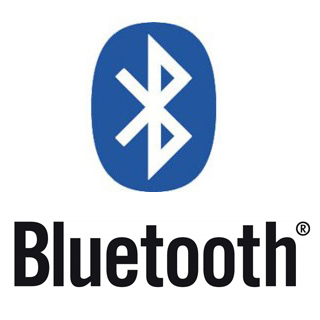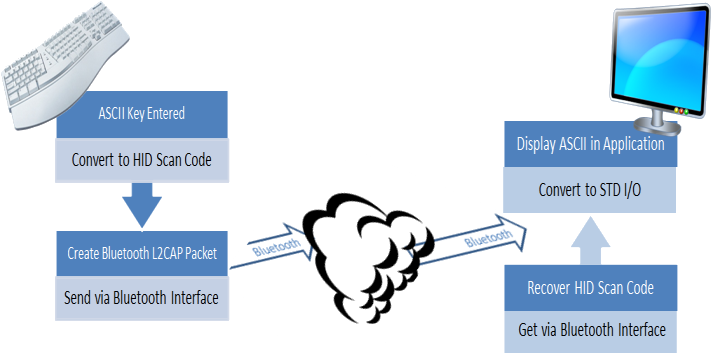Bluetooth Basics
Bluetooth is a standardized protocol for sending and receiving data via a 2.4GHz wireless link. It’s a secure protocol, and it’s perfect for short-range, low-power, low-cost, wireless transmissions between electronic devices.

These days it feels like everything is wireless, and Bluetooth is a big part of that wireless revolution. You’ll find Bluetooth embedded into a great variety of consumer products, like headsets, video gamecontrollers, or our smartphone relay.
In our world of embedded electronics hackery, Bluetooth serves as an excellent protocol for wirelessly transmitting relatively small amounts of data over a short range (<100m). It’s perfectly suited as a wireless replacement for serial communication interfaces. Or you can use it to create a DIY HID Computer Keyboard. Or, with the right module, it can be used to build a homebrew, wireless MP3-playing speaker.
Bluetooth Profiles
Bluetooth profiles are additional protocols that build upon the basic Bluetooth standard to more clearly define what kind of data a Bluetooth module is transmitting. While Bluetooth specifications define how the technology works, profiles define how it’s used.
The profile(s) a Bluetooth device supports determine(s) what application it’s geared towards. A hands-free Bluetooth headset, for example, would use headset profile (HSP), while a Nintendo Wii Controller would implement the human interface device (HID) profile. For two Bluetooth devices to be compatible, they must support the same profiles.
Let’s take a look at a few of the more commonly-encountered Bluetooth profiles.
Serial Port Profile (SPP)
If you’re replacing a serial communication interface (like RS-232 or a UART) with Bluetooth, SPP is the profile for you. SPP is great for sending bursts of data between two devices. It’s is one of the more fundamental Bluetooth profiles (Bluetooth’s original purpose was to replace RS-232 cables after all).
Using SPP, each connected device can send and receive data just as if there were RX and TX lines connected between them. Two Arduinos, for example, could converse with each other from across rooms, instead of from across the desk.
Human Interface Device (HID)
HID is the go-to profile for Bluetooth-enabled user-input devices like mice, keyboards, and joysticks. It’s also used for a lot of modern video game controllers, like WiiMotes or PS3 controllers.

Example HID interface
Bluetooth’s HID profile is actually a riff on the HID profile already defined for human input USB devices. Just as SPP serves as a replacement for RS-232 cables, HID aims to replace USB cables (a much taller task!).
Hands-Free Profile (HFP) and Headset Profile (HSP)
Those Bluetooth earpieces that makes important business guys look like self-conversing wackos? Those usually use headset profile (HSP) or hands-free profile (HFP).
HFP is used in the hands-free audio systems built into cars. It implements a few features on top of those in HSP to allow for common phone interactions (accepting/rejecting calls, hanging up, etc.) to occur while the phone remains in your pocket.
Advanced Audio Distribution Profile (A2DP)
Advanced audio distribution profile (A2DP) defines how audio can be transmitted from one Bluetooth device to another. Where HFP and HSP send audio to and from both devices, A2DP is a one-way street, but the audio quality has the potential to be much higher. A2DP is well-suited to wireless audio transmissions between an MP3 player and a Bluetooth-enabled stereo.
Most A2DP modules support a limited set of audio codecs. In the least they’ll suport SBC (subband codec), they may also support MPEG-1, MPEG-2, AAC, and ATRAC.
A/V Remote Control Profile (AVRCP)
The audio/video remote control profile (AVRCP) allows for remote controlling of a Bluetooth device. It’s usually implemented alongside A2DP to allow the remote speaker to tell the audio-sending device to fast-forward, rewind, etc.
Common Versions
Bluetooth has been constantly evolving since it was conceived in 1994. The most recent update of Bluetooth, Bluetooth v4.0, is just beginning to gain traction in the consumer electronics industry, but some of the previous versions are still widely used. Here’s a rundown of the commonly encountered Bluetooth versions:
Bluetooth v1.2
The v1.x releases laid the groundwork for the protocols and specifications future versions would build upon. Bluetooth v1.2 was the latest and most stable 1.x version.
These modules are rather limited compared to later versions. They support data rates of up to 1 Mbps (more like 0.7 Mbps in practice) and 10 meter maximum range.
Bluetooth v2.1 + EDR
The 2.x versions of Bluetooth introduced enhanced data rate (EDR), which increased the data rate potential up to 3 Mbps (closer to 2.1 Mbps in practice). Bluetooth v2.1, released in 2007, introduced secure simple pairing (SSP), which overhauled the pairing process.
Bluetooth v2.1 modules are still very common. For low-speed microcontrollers, where 2 Mbps is still fast, v2.1 gives them just about everything they could need. The RN-42 Bluetooth module, for example, remains popular in products like the Bluetooth Mate and BlueSMiRF HID.
Bluetooth v3.0 + HS
You thought 3 Mbps was fast? Multiply that by eight and you have Bluetooth v3.0’s optimum speed – 24 Mbps. That speed can be a little deceiving though, because the data is actually transmitted over a WiFi (802.11) connection. Bluetooth is only used to establish and manage a connection.
It can be tricky to nail down the maximum data rate of a v3.0 device. Some devices can be “Bluetooth v3.0+HS”, and others might be labeled “Bluetooth v3.0”. Only those devices with the “+HS” suffix are capable of routing data through WiFi and achieving that 24 Mbps speed. “Bluetooth v3.0” devices are still limited to a maximum of 3 Mbps, but they do support other features introduced by the 3.0 standard like better power control and a streaming mode.
Bluetooth v4.0 and Bluetooth Low Energy
Bluetooth 4.0 split the Bluetooth specification into three categories: classic, high-speed, and low-energy. Classic and high speed call back to Bluetooth versions v2.1+EDR and v3.0+HS respectively. The real standout of Bluetooth v4.0 is Bluetooth low energy (BLE).
BLE is a massive overhaul of the Bluetooth specifications, aimed at very low power applications. It sacrifices range (50m instead of 100m) and data throughput (0.27 Mbps instead of 0.7-2.1 Mbps) for a significant savings in power consumption. BLE is aimed at peripheral devices which operate on batteries, and don’t require high data rates, or constant data transmission. Smartwatches, like the MetaWatch, are a good example of this application.
